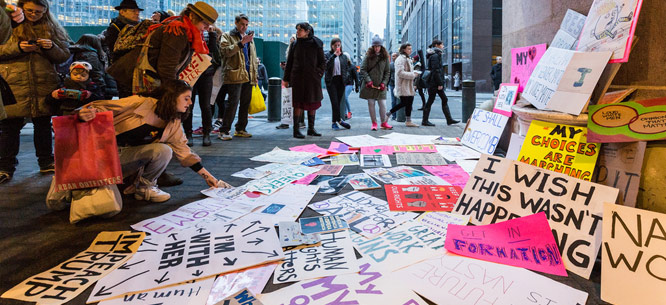New York’s Homegrown Women’s March
New York’s Homegrown Women’s March
The 53 percent of white women who voted for Trump represent a major political constituency; but if Saturday was any indication, they may before long be outnumbered by the likes of the marchers I saw holding signs that said, “Women are not up for grabs.”

The Women’s March on New York that followed Donald Trump’s inauguration never got the buildup, even in New York papers, that the much bigger Women’s March on Washington did. But from my perspective as a marcher, the lack of buildup was a bonus. It allowed the New York march—far larger than anyone there could have expected—to take on an inner life of its own.
The speeches by, among others, Chirlane McCray, the wife of Mayor Bill de Blasio, and actors Cynthia Nixon and Helen Mirren that began the march did not define it. Nor did the appearance of Senator Chuck Schumer at points along the march route do more than draw polite applause.
What set the tone for the day were the individual expressions of anger and hope, epitomized by the homemade signs that marchers brought with them. The signs were filled with the kinds of puns and social commentary that no political organization would ever come up with on its own.
My favorite sign was one that took on theologian Reinhold Niebuhr’s famous Serenity Prayer and its plea, “God grant me the serenity to accept the things I cannot change.” The message on the sign declared, “I am no longer accepting the things I can’t change. I am changing the things I can’t accept.”
I felt optimistic about the march from the moment I got on the subway taking me there. I sat across the aisle from a mother and her ten-year-old daughter, both wearing dayglo-green hats and carrying a four-foot sign that said, “You can’t comb over sexism.” If they got separated, this mother and daughter weren’t going to lose sight of each other.
They were right to choose the color they did. The hat setting the tone for the day was the knit, pink pussy hat with cat ears that, thanks to the Pussyhat Project, has become a widespread symbol of opposition to Donald Trump’s remarks about grabbing women by their pussy. But in this crowd, in which the gender ratio was at least two-to-one women-to-men, nobody was going to push or shove in a way that would have caused a mother and daughter to become separated.
I spent the afternoon with faculty from the college where I teach. Two of them had grandmothers who had been suffragists, and a number of faculty brought their sons and daughters to the march. For me the great indicator of the mood of the crowd was the number of conversations that marchers struck up with those they didn’t know. It seemed good manners, not intrusiveness, to talk politics with strangers.
Marchers could count on getting help for almost any difficulty they encountered. One mother and her college-age daughter lost patience with waiting in line at a designated march entry point and decided it would be quicker to jump the metal barriers the police had set up to keep the march from spilling onto the sidewalk. The daughter climbed the metal barrier with ease. It was a different story for her mother. Despite any number of helping hands, climbing the barrier was too much for her. So she got on the ground and, cheerfully sacrificing her dignity, wiggled under the barrier. “Don’t anyone step on my mother,” her daughter jokingly shouted to those coming on the scene for the first time.
What surprised me about the crowd were the many marchers I didn’t expect to see. They included a retired policewoman wearing her NYPD blue jacket and two sisters carrying a sign that said, “Daughters of Irish Immigrants Stand for Our Rights.” The sisters were, by chance, just behind a group of women with a Spanish-language sign that read, “Respeta mi existencia.”
At its quickest, the march, which began near the United Nations, took fifteen minutes to cover a city block, and it was not until late in the afternoon that I got to the march’s end at 55th Street and Fifth Avenue. I had expected we would be allowed to go the additional block and stop outside Trump Tower, which sits between 56th and 57th Street on Fifth Avenue. That’s been the final rallying site for most the post-election protests. But the police stopped us at 55th Street, guaranteeing that the street directly in front of Trump Tower would remain deserted.
The quiet end of the march did not, though, feel anti-climactic. There is no complaining when upwards of 400,000 people show up for a protest. The question for me is: how many in this crowd and in the crowds at the women’s marches across the nation will support the hard political work that lies ahead? Self-expression is fine as far as it goes, but the key to political success for today’s left remains building institutions and movements that can have a permanent impact.
During the election, one of the most ominous indications of how the vote would go was the size and enthusiasm of the crowds at Trump rallies. The 53 percent of white women who voted for Trump represent a major political constituency; but if Saturday was any indication, they may before long be outnumbered by the likes of the marchers I saw holding signs that said, “Women are not up for grabs.”
Nicolaus Mills chairs the literature department at Sarah Lawrence College. He is author of Winning the Peace: The Marshall Plan and America’s Coming of Age as a Superpower.
Read more responses to Saturday’s women’s marches by Dissent editors.





